Surprising writing essentials from early 1900s UK
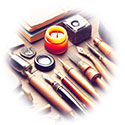
This page is based on the contents of an old desk belonging to a man who died in 1939 and which was not opened again until this page was prepared. The contents tell a lot about the essentials for written communication as they were in the early 1900s. Of particular mention are the sticks of sealing wax and a variety of pen nibs. There are descriptions and explanations of both of these.
My grandfather's portable Victorian or Edwardian desk lay untouched from his death in 1939 to when I opened it to photograph it. Since he lived into old age, the contents must be little different from what they would have been in the early 20th century, in Victorian and Edwardian times or even before.
Sealing wax
Sticks of well-used sealing wax were in the bottom compartment of the desk.
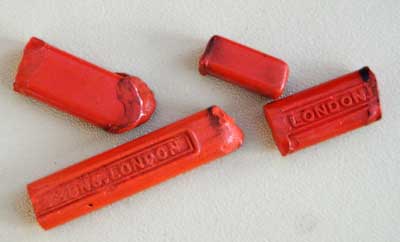
Sticks of partly-used sealing wax
The purpose of sealing wax was to show that a sealed document had not been tampered with between sending and arrival. It was used for important or private documents and valuable parcels.
Sealing wax is based on beeswax.
How sealing wax was used
To use sealing wax, the sender put an end of the sealing wax strip into a flame to soften it and then daubed or dripped over the sealed or knotted part of the envelope or parcel string. The sealing wax cooled and solidified rapidly, making a lump that was so brittle that it chipped or broke easily. Consequently if anyone tried to tamper with the seal, the tampering was immediately obvious.
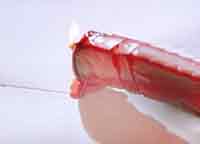
Hot, melted sealing wax being daubed into the sealed part of an envelope.
Better-off people had what was called a 'seal', something which made a personalised impression in the hot wax, usually the individual's initials or a coat of arms. Usually the seal was part of a finger ring. The likes of my grandfather, i.e. working-class people, would not have owned such a thing.
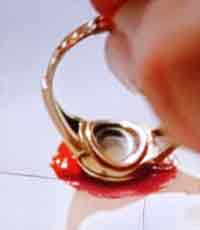
A ring with a 'seal' being pressed into sealing wax to replicate the design on the ring which was unique to the sender - usually initials or a crest.
In the 1940s my parents owned sealing wax. I only remember it being used once - and that stuck firmly in my memory because of how the sealing wax sparked while it was in the flame.
I clearly remember letters and parcels arriving with sealing wax on. Then it was mainly on the knot of the string which tied parcels.
Why my father used sealing wax
contributed by Neil Cryer, personal recollection
I can remember my father sealing a letter. He had an engraved signet ring and he explained that by pressing the ring into the still hot soft wax, it showed it was he who had sealed the letter. No one else could tamper with it and reseal it to look like the original as only he had that ring.
The pens
The pens in the desk are best shown in the following photographs.

The pen compartment, with is original pens. The handles of two of the pens are bone, and the other is wood.
Pen with bone handle. Note how inky the handle is.
Pen nibs
All the nibs are for what are called dip pens because they had to be dipped into ink every line or so of writing.
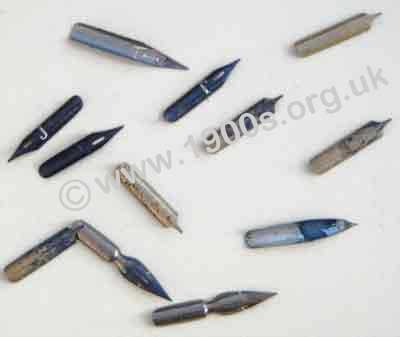
Nibs stored in the desk. Clearly these have been well-used, mainly with blue ink - presumably my grandfather's favourite colour. As they all seem well-used, my grandfather must have interchanged them frequently, and I wonder why he would have done this. Different widths of tips give different width letters, but all but the central nib in the image look equally narrow.

Enlargement of the nib housing. There are two concentric metal grips, the outer is slit so that it can be forced open.

Nib in place, having been forced between the two grips and then held firm. When (not if) the nib breaks, it can be forcibly removed and replaced with a new one
Pen nibs could actually be quite complex with all sorts of slightly different arrangements for different styles of writing, types of paper and smoothness of flow. For ordinary use, dip pen nibs had a small round reservoir in them which could store ink for a line or two of writing before needing to be dipped back into the ink for a refill. The ink was delivered down a channel which opened up as the nib pressed onto the paper. With fountain pen nibs, the ink was stored inside the pen in its rubber reservoir and the ink was delivered down a similar channel which open up with pressure.

Dip-pen nib. Note its round ink reservoir. You may just be able to see the channel from the reservoir to the nib tip.

Fountain pen nib with no reservoir in it as the ink is stored inside the pen.
Miscellanea in the desk
Also found in the desk, mostly not shown, are two well-used rubbers (erasers), paperclips, a wooden pencil with a particularly thick lead probably for use in carpentry, a nearly dried-up bottle of black ink, non-matching sheets of paper, brown envelopes and an unused 1939 diary.
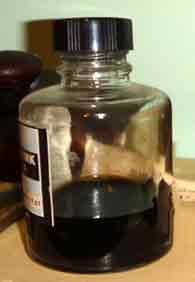
Old ink bottle with black ink
If my grandfather had not been so ill when he died, the desk would probably also have contained unanswered letters.
| sources | webmaster | contact |
Text and images are copyright
If you can add anything to this page or provide a photo, please contact me.




